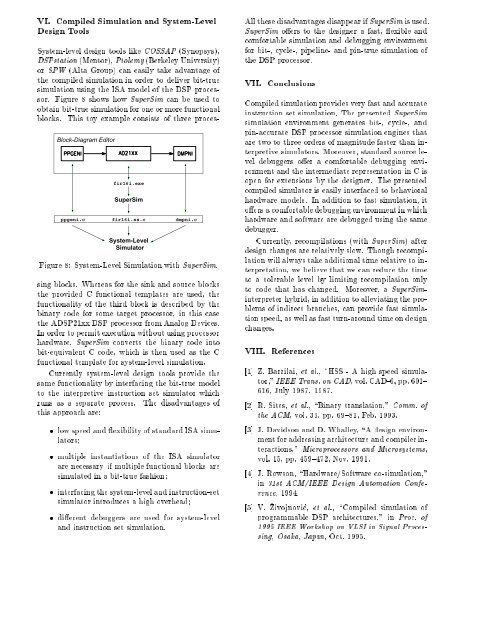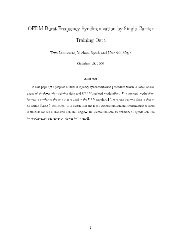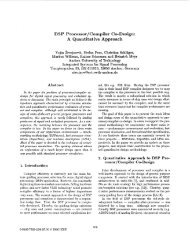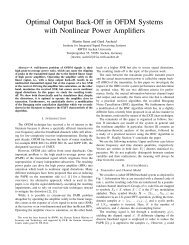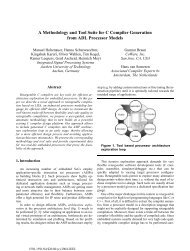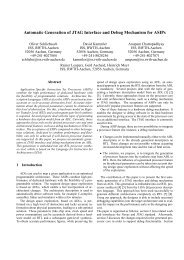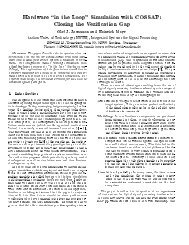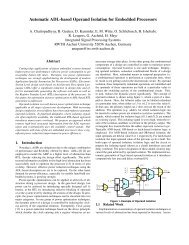supersim | a new technique for simulation of programmable ... - ICE
supersim | a new technique for simulation of programmable ... - ICE
supersim | a new technique for simulation of programmable ... - ICE
You also want an ePaper? Increase the reach of your titles
YUMPU automatically turns print PDFs into web optimized ePapers that Google loves.
VI. Compiled Simulation and System-Level<br />
Design Tools<br />
Block-Diagram Editor<br />
System-level design tools like COSSAP (Synopsys),<br />
DSPstation (Mentor), Ptolemy (Berkeley University)<br />
or SPW (Alta Group) can easily take advantage <strong>of</strong><br />
the compiled <strong>simulation</strong> in order to deliver bit-true<br />
<strong>simulation</strong> using the ISA model <strong>of</strong> the DSP processor.<br />
Figure 8 shows how SuperSim can be used to<br />
obtain bit-true <strong>simulation</strong> <strong>for</strong> one or more functional<br />
blocks. This toy example consists <strong>of</strong> three procesppgeni.c<br />
fir16i.exe<br />
SuperSim<br />
fir16i.ss.c<br />
System-Level<br />
Simulator<br />
dmpni.c<br />
Figure 8: System-Level Simulation with SuperSim.<br />
sing blocks. Whereas <strong>for</strong> the sink and source blocks<br />
the provided C functional templates are used, the<br />
functionality <strong>of</strong> the third block is described by the<br />
binary code <strong>for</strong> some target processor, in this case<br />
the ADSP21xx DSP processor from Analog Devices.<br />
In order to permit execution without using processor<br />
hardware, SuperSim converts the binary code into<br />
bit-equivalent C code, which is then used as the C<br />
functional template <strong>for</strong> system-level <strong>simulation</strong>.<br />
Currently system-level design tools provide the<br />
same functionality byinterfacing the bit-true model<br />
to the interpretive instruction set simulator which<br />
runs as a separate process. The disadvantages <strong>of</strong><br />
this approach are:<br />
low speed and exibility <strong>of</strong> standard ISA simulators<br />
multiple instantiations <strong>of</strong> the ISA simulator<br />
are necessary if multiple functional blocks are<br />
simulated in a bit-true fashion<br />
interfacing the system-level and instruction-set<br />
simulator introduces a high overhead<br />
dierent debuggers are used <strong>for</strong> system-level<br />
and instruction set <strong>simulation</strong>.<br />
All these disadvantages disappear if SuperSim is used.<br />
SuperSim oers to the designer a fast, exible and<br />
com<strong>for</strong>table <strong>simulation</strong> and debugging environment<br />
<strong>for</strong> bit-, cycle-, pipeline- and pin-true <strong>simulation</strong> <strong>of</strong><br />
the DSP processor.<br />
VII. Conclusions<br />
Compiled <strong>simulation</strong> provides very fast and accurate<br />
instruction set <strong>simulation</strong>. The presented SuperSim<br />
<strong>simulation</strong> environment generates bit-, cycle-, and<br />
pin-accurate DSP processor <strong>simulation</strong> engines that<br />
are two to three orders <strong>of</strong> magnitude faster than interpretive<br />
simulators. Moreover, standard source level<br />
debuggers oer a com<strong>for</strong>table debugging environment<br />
and the intermediate representation in C is<br />
open <strong>for</strong> extensions by the designer. The presented<br />
compiled simulator is easily interfaced to behavioral<br />
hardware models. In addition to fast <strong>simulation</strong>, it<br />
oers a com<strong>for</strong>table debugging environmentinwhich<br />
hardware and s<strong>of</strong>tware are debugged using the same<br />
debugger.<br />
Currently, recompilations (with SuperSim) after<br />
design changes are relatively slow. Though recompilation<br />
will always take additional time relative to interpretation,<br />
we believe thatwe can reduce the time<br />
to a tolerable level by limiting recompilation only<br />
to code that has changed. Moreover, a SuperSiminterpreter<br />
hybrid, in addition to alleviating the problems<br />
<strong>of</strong> indirect branches, can provide fast <strong>simulation</strong><br />
speed, as well as fast turn-around time on design<br />
changes.<br />
VIII. References<br />
[1] Z. Barzilai, et al., \HSS - A high speed simulator,"<br />
IEEE Trans. on CAD,vol. CAD-6, pp. 601{<br />
616, July 1987. 1987.<br />
[2] R. Sites, et al., \Binary translation," Comm. <strong>of</strong><br />
the ACM, vol. 36, pp. 69{81, Feb. 1993.<br />
[3] J. Davidson and D. Whalley, \A design environment<br />
<strong>for</strong> addressing architecture and compiler interactions,"<br />
Microprocessors and Microsystems,<br />
vol. 15, pp. 459{472, Nov. 1991.<br />
[4] J. Rowson, \Hardware/S<strong>of</strong>tware co-<strong>simulation</strong>,"<br />
in 31st ACM/IEEE Design Automation Conference,<br />
1994.<br />
[5] V. Zivojnovic, et al., \Compiled <strong>simulation</strong> <strong>of</strong><br />
<strong>programmable</strong> DSP architectures," in Proc. <strong>of</strong><br />
1995 IEEE Workshop on VLSI in Signal Processing,<br />
Osaka, Japan, Oct. 1995.


